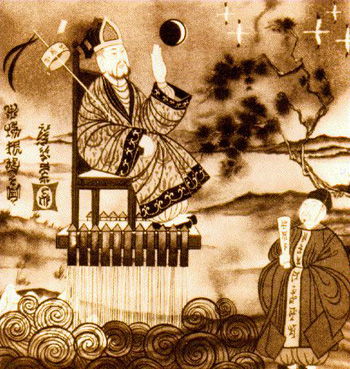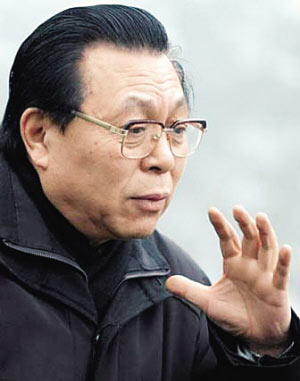The nation's first moon orbiter is scheduled to blast off at 6:05 PM today from the Xichang Satellite Launch Center in southwest China's Sichuan Province. Eager Chinese people are scrambling for the over-1,000-yuan (US$133.45) ticket to have the opportunity to watch the Chang'e I soar up into the sky in the vicinity of the launching site, according to the journal Global People.
The Chang'e I satellite is named after Chang'e, a famous character from Chinese mythology. According to legend, she ascended from earth to live on the moon as a celestial being after drinking a magical elixir. This beautiful myth has been told by generations of Chinese people.
In reality, however, China's road to the moon has not been very smooth. In past years, untold Chinese people have made Herculean efforts to fulfill the dream their ancestors have cherished for thousands of years.
Wan Hu: the pioneer of moon exploration
In the 1970s, the International Astronomical Union (IAU) named a lunar crater after Wan Hu to honor his bold attempt at space exploration.
Widely reputed as the world's first "astronaut", Wan Hu was a minor Chinese official of the Ming Dynasty (1368-1644). Early in the 16th century, Wan Hu decided to take advantage of China's advanced power and fireworks technology to launch himself into outer space. He had a chair built with 47 "rockets" attached. On the day of lift-off, Wan climbed into his rocket chair and held one enormous kite in each hand. The ignition of the 47 fuses caused a huge explosion and sent him into the sky. But unfortunately, he failed to go into orbit and his body smashed into pieces on the ground.
In 2003 and 2005 respectively, China successfully launched two manned spacecraft: Shenzhou V and Shenzhou VI. At present, Chinese scientists are busy preparing for another grand outer space program: the lunar probing program.
Ouyang Ziyuan: how did China's lunar probing project come out
On February 13, 2004, the Commission of Science, Technology and Industry for National Defense announced that the lunar probing project has entered the implementation phase: within three years, China's first lunar satellite would be sent into the orbit. Within the next six years, a Chinese moon rover shall land on the moon and cruise its surface. Before 2020, a China-made robot is expected to bring back samples of the soil on the moon.
In the eyes of Ouyang Ziyuan, chief scientist of China's lunar probing project, these great achievements in moon exploration are due to the contributions of generations of diligent Chinese scientists, who all started their work under extremely difficult conditions and carried forward the cause with unremitting efforts.
"China's research on the moon started 25 years ago with a 0.5-gram lunar rock sample," said Ouyang Ziyuan.
In 1978, when US national security adviser Zbigniew Brzezinski visited China, he sent a special gift to the Chinese leaders on behalf of US President Jimmy Carter. The gift was a moon rock as small as a fingertip. It was stored carefully in a delicate box. Looking from outside, it was large but it actually only weighed one gram.
The rock was sent to scientific research institutions; they contacted Ouyang Ziyuan. "The moon rock was cut into two. One half was carefully kept by government authorities and we started research on the other half." According to Ouyang Ziyuan, this was a chance for China to show its capacity to conduct outer space research. "Spurred by such a motive, we devoted ourselves to the study of the moon rock. Our research result later convinced the US scientists."
With leaps and bounds in China's overall development, 25 years later, what is in front of the Chinese scientists is no longer a one-gram rock from the moon. The Chang'e I will offer them the whole vista of the moon itself.
On August 10, 2007, scientists started to prepare for the launch of the Chang'e I satellite. On September 16, the lunar orbiter was transported to the launching site. Scientists revealed that the satellite would be launched at the end of 2007. The first choice was around 6 PM on October 24.
The first proposal of sending objects to the moon was made 15 years ago. In 1992, some scientists suggested sending an iron souvenir onto the moon to celebrate Hong Kong's return to the motherland in 1997. The proposal made a splash in the academic circles. However, it was rejected by the central government for it had no scientific worth.
Inspired by this idea, scientists in the National High-tech R&D Program, also known as national 863 Program, asked Ouyang Ziyuan to draw up a plan on lunar exploration. In 1994, Ouyang's report was approved. The central government appropriated China's first funds for moon probing activities. In the years that followed, top state leaders have paid special attention to the progress of the moon exploration project. They have read through piles of scientific reports and encouraged the scientists greatly. On January 24, 2004, Premier Wen Jiabao signed the report of Chang'e I satellite launching plan.
According to the plan, when the orbiter is sent into outer space, it is expected to conduct a string of tasks including the capture of 3-D images and analysis of the distribution of elements on the moon's surface. After one-year of space travel, the satellite will hit the moon as part of the research mission. The moment it crashes on the moon, it will shoot high-resolution photos of the moon surface and send back important data concerning the crash.
In addition, the Chang'e I will broadcast 32 Chinese songs on its orbit 380,000 kilometers away from the earth.
What is expected in China's future moon exploration project?
With regard to the future of China's moon exploration activities, Ouyang Ziyuan has already had a clear picture. In 2012, the first China moon rover will land on the moon. Then, an intelligent robot will walk out to collect samples of the materials on the moon. By 2017, the robot will be recalled back and scientists will start research on the samples it brings home.
(China.org.cn by Chen Xia, October 24, 2007)



